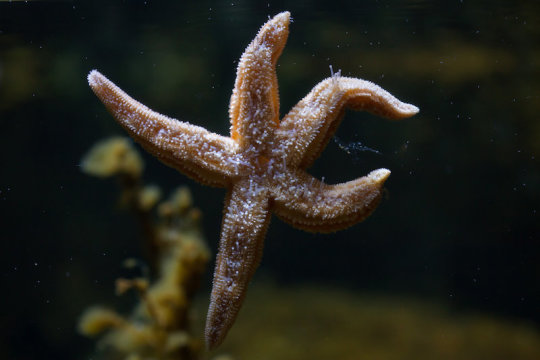[ad_1]
A hormone that is released in our brain when we fall in love also makes starfish turn their stomach inside out to feed, according to a new study from Queen Mary University of London.
Oxytocin, more commonly known as the ‘love hormone’, is important for sexual reproduction in humans, other mammals and even nematode worms, but this study shows that in the common European starfish (Asterias rubens) it is important for feeding.
The findings, published in the journal BMC Biology, could play an important role in controlling the feeding behavior of the crown of thorns starfish (Acanthaster planci), which feeds on coral and is having a devastating impact on the Australian Great Barrier Reef.
Based on this study the researchers know that oxytocin-type molecules have been acting in the nervous systems of animals for over half-a-billion years.
However, the effects on feeding can be very different in different animal types — in starfish oxytocin-type molecules seem to be important for normal feeding to occur whereas studies on mice have revealed that oxytocin inhibits feeding behaviour.
Professor Maurice Elphick, lead author of the study from Queen Mary University of London, said: “Our study has provided important new evidence that oxytocin-type molecules are important and ancient regulators of feeding in animals. So oxytocin is much more than a ‘love hormone’ — perhaps especially for animals like starfish that don’t fall in love!”
Esther Odekunle, formerly a PhD student at Queen Mary University of London, added: “If the ‘love hormone’ plays a role in the feeding behaviour of the crown of thorns starfish, then this research may provide a basis for the development of novel chemical methods to control their appetite for coral.”
To investigate the role of the hormone, the researchers had to inject it into the starfish to see if anything happened.
Within a few minutes the injected starfish started bending their arms and adopted a ‘humped’ posture similar to the posture used when they are feeding. Furthermore, it caused the starfish to evert their stomach out of their mouth.
This was an interesting combination of effects because starfish feed naturally by climbing on top of prey such as mussels or oysters and adopting a rigid humped posture so that they can employ the pulling power of lots of tiny tube feet on the underside of each arm to pull apart the two valves of their prey.
Having created a tiny gap, the starfish then evert their stomach out of their mouth, through the gap and into the body of the prey — where they proceed to digest the soft tissues of the prey into a soup-like mixture, which is then drawn back into the starfish as food.
When all of the prey tissue has been digested the starfish withdraws its stomach back into its mouth, leaving behind an empty shell and moving off to find its next victim.
Professor Elphick said: “What is fascinating is that injecting the hormone in starfish induces what is known as fictive feeding. The starfish are behaving as if they are feeding on a mussel or an oyster but no mussel or oyster is there to be eaten.”
The researchers found that the effect of the hormone is so powerful it made starfish 2-3 times slower at righting themselves when flipped over. This is an important defense behavior in nature as they can be upturned by strong waves.
What they also found was that both the hormone and its receptor are found in many regions of the starfish body — including the central nervous system and the stomach. These findings are consistent with the striking effects of the oxytocin-like molecule on starfish behaviour.
The research was funded by the BBSRC, Leverhulme Trust and Society for Experimental Biology.
[ad_2]















